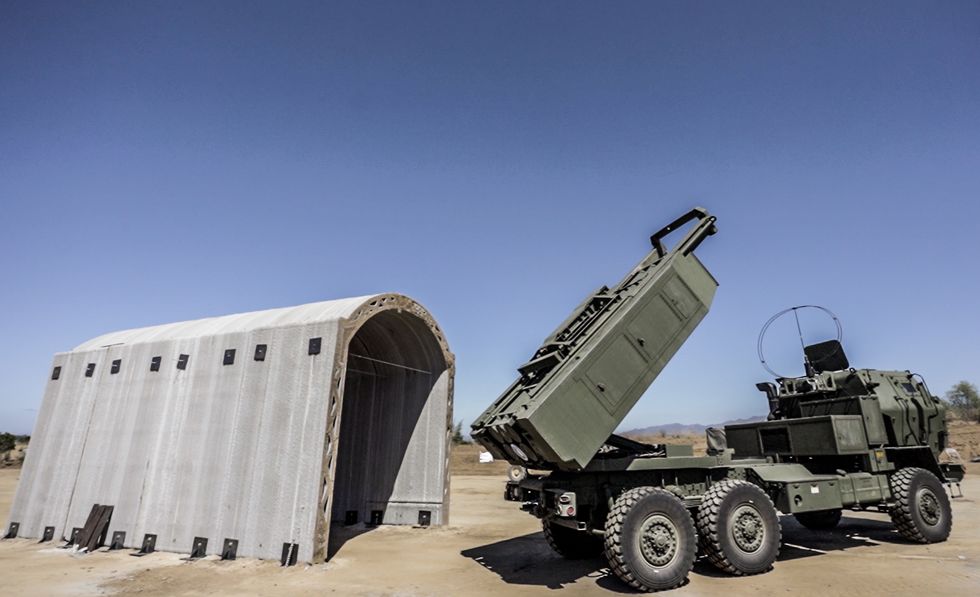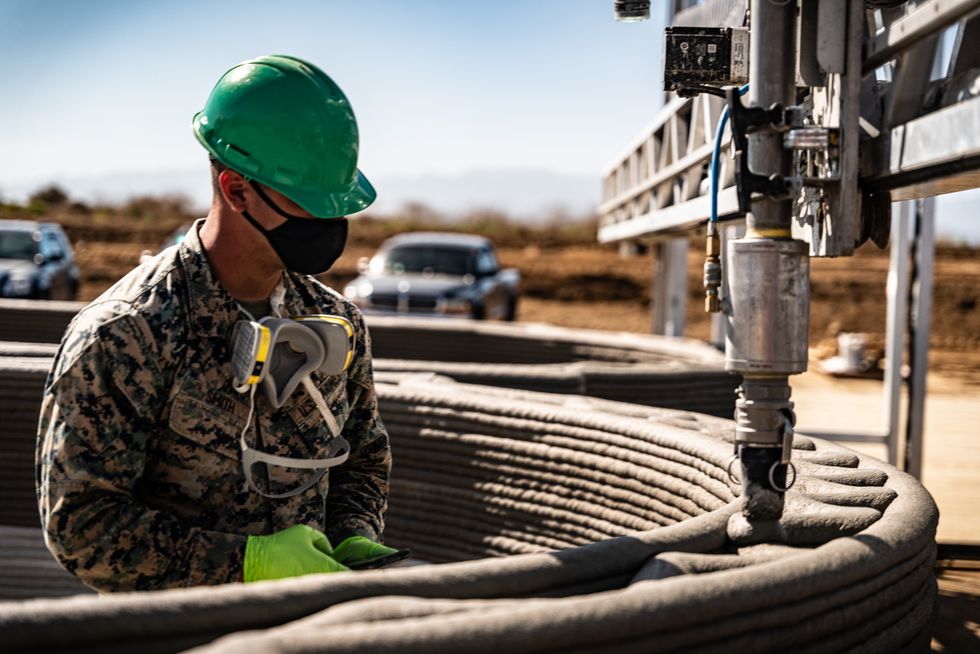Post by bazooka on Aug 9, 2020 23:57:39 GMT
The Marines 3D-Printed a Rocket Launcher Shelter in 36 Hours
Meet the newest tool in their arsenal: a 3,800-pound beast named the Vulcan.
BY KYLE MIZOKAMI

The Marine Corps recently tested a 3D printer capable of fabricating entire buildings within hours.
The shelter was built to accommodate a HIMARS multiple launch rocket system.
3D printing promises stronger, more durable structures for a more mobile Marine Corps.
The U.S. Marines recently tested a 3D printer capable of constructing entire buildings with quick-drying concrete. In just 36 hours, ICON's Vulcan 3D printer whipped up a concrete structure that can hold a HIMARS truck-mounted multiple rocket launcher system.
The result is a durable structure that can be built virtually anywhere the Marines deploy, sheltering personnel, vehicles, and supplies from the weather. See the printer in action here:
The Vulcan is a 3,800-pound beast that's designed to spray layers of proprietary Lavacrete, which is a fast-curing polymer concrete that can be ready for use as soon as 12 to 24 hours after printing. Lavacrete has a strength rating of 6,000 pounds per square inch (psi).
The Rock Solid History of Concrete
The Vulcan printer works by spraying down layers of the Lavacrete that harden into horizontal cross-sections of the building. Engineers can then lift the cross-sections upright and assemble them into a complete building. The process is akin to building a salami stick out of individually made slices.

vulcan, icon, 3d printing
The Vulcan 3D printer printing one of four arches. Once the arches were completed, they were raised upright and assembled into a single structure.
In a recent test at Marine Corps Base Camp Pendleton in southern California, the Marines built a shelter for a M142 HIMARS multiple launch rocket system in just a day and half. The Marines printed four 26-by-13-by-15-foot arches, then assembled them together to create a single building.
Once the building was complete, the Marines rolled the truck-mounted weapon system inside for a fit check. The result was a weatherproof shelter that can protect Marines and their equipment from the elements, including tropical weather, enemy weapons fire, and even radiation.
The Vulcan, which operators control with a tablet, can print an 8.5-by-28-foot structure at a rate of 5 to 7 inches a second. It can print structures up to 2,000 square feet and has been used to build complete houses in the U.S. and Mexico. The Vulcan is fed by ICON’s Magma material delivery system, which mixes the Lavacrete ingredients to produce a building material tuned to temperature, altitude, and humidity.
marines with delta battery, 2d battalion, 14th marines, 14th marine regiment, assigned to iii marine expeditionary force, drive high mobility artillery rocket systems onto a landing craft air cushion for the first time in south korea, during exercise ssang yong 14, pohang, south korea, april 2, 2014 exercise ssang yong is conducted annually in the rok to enhance interoperability between us and rok forces by performing a full spectrum of amphibious operations while showcasing sea based power projection in the pacific us marine corps photo by cpl lauren whitneyreleased
A HIMARS rocket launcher rolls off a LCAC hovercraft during exercise Ssang Yong 14. On small islands HIMARS vehicles will not be able to maneuver away from enemy fire and will need protection to survive.
CPL. LAUREN WHITNEY/DVIDS
A system like Vulcan is right up the alley of the new, leaner Marine Corps. The Marine Corps is in the midst of a reorganization designed with China in mind, reorienting from a second land army to an island-hopping force capable of operating in the South China Sea. Once the Marines seize an island from the enemy, they'll have to dig in to repel enemy air, missile, and ground counterattacks.
Meet the newest tool in their arsenal: a 3,800-pound beast named the Vulcan.
BY KYLE MIZOKAMI
himars, vulcan, 3d printing
The shelter was built to accommodate a HIMARS multiple launch rocket system.
3D printing promises stronger, more durable structures for a more mobile Marine Corps.
The U.S. Marines recently tested a 3D printer capable of constructing entire buildings with quick-drying concrete. In just 36 hours, ICON's Vulcan 3D printer whipped up a concrete structure that can hold a HIMARS truck-mounted multiple rocket launcher system.
The result is a durable structure that can be built virtually anywhere the Marines deploy, sheltering personnel, vehicles, and supplies from the weather. See the printer in action here:
The Vulcan is a 3,800-pound beast that's designed to spray layers of proprietary Lavacrete, which is a fast-curing polymer concrete that can be ready for use as soon as 12 to 24 hours after printing. Lavacrete has a strength rating of 6,000 pounds per square inch (psi).
The Rock Solid History of Concrete
The Vulcan printer works by spraying down layers of the Lavacrete that harden into horizontal cross-sections of the building. Engineers can then lift the cross-sections upright and assemble them into a complete building. The process is akin to building a salami stick out of individually made slices.
The Vulcan 3D printer printing one of four arches. Once the arches were completed, they were raised upright and assembled into a single structure.
In a recent test at Marine Corps Base Camp Pendleton in southern California, the Marines built a shelter for a M142 HIMARS multiple launch rocket system in just a day and half. The Marines printed four 26-by-13-by-15-foot arches, then assembled them together to create a single building.
Once the building was complete, the Marines rolled the truck-mounted weapon system inside for a fit check. The result was a weatherproof shelter that can protect Marines and their equipment from the elements, including tropical weather, enemy weapons fire, and even radiation.
The Vulcan, which operators control with a tablet, can print an 8.5-by-28-foot structure at a rate of 5 to 7 inches a second. It can print structures up to 2,000 square feet and has been used to build complete houses in the U.S. and Mexico. The Vulcan is fed by ICON’s Magma material delivery system, which mixes the Lavacrete ingredients to produce a building material tuned to temperature, altitude, and humidity.
marines with delta battery, 2d battalion, 14th marines, 14th marine regiment, assigned to iii marine expeditionary force, drive high mobility artillery rocket systems onto a landing craft air cushion for the first time in south korea, during exercise ssang yong 14, pohang, south korea, april 2, 2014 exercise ssang yong is conducted annually in the rok to enhance interoperability between us and rok forces by performing a full spectrum of amphibious operations while showcasing sea based power projection in the pacific us marine corps photo by cpl lauren whitneyreleased
A HIMARS rocket launcher rolls off a LCAC hovercraft during exercise Ssang Yong 14. On small islands HIMARS vehicles will not be able to maneuver away from enemy fire and will need protection to survive.
CPL. LAUREN WHITNEY/DVIDS
A system like Vulcan is right up the alley of the new, leaner Marine Corps. The Marine Corps is in the midst of a reorganization designed with China in mind, reorienting from a second land army to an island-hopping force capable of operating in the South China Sea. Once the Marines seize an island from the enemy, they'll have to dig in to repel enemy air, missile, and ground counterattacks.











